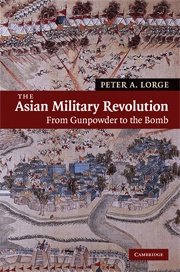Book contents
- Frontmatter
- Contents
- List of maps
- Acknowledgments
- Chronology
- Glossary
- Introduction
- 1 China through the Yuan
- 2 Japan and the wars of unification
- 3 The Chinese military revolution and war in Korea
- 4 Southeast Asia
- 5 South Asia to 1750
- 6 The military revolution in South Asia, 1750–1850
- 7 The arrival and departure of the West
- Conclusion
- Index
- References
7 - The arrival and departure of the West
Published online by Cambridge University Press: 05 June 2012
- Frontmatter
- Contents
- List of maps
- Acknowledgments
- Chronology
- Glossary
- Introduction
- 1 China through the Yuan
- 2 Japan and the wars of unification
- 3 The Chinese military revolution and war in Korea
- 4 Southeast Asia
- 5 South Asia to 1750
- 6 The military revolution in South Asia, 1750–1850
- 7 The arrival and departure of the West
- Conclusion
- Index
- References
Summary
When Europeans first reached Asia, their guns were slightly more advanced than what was locally available. Nevertheless, European weapons were quickly adopted when their superiority was demonstrated. As more and better European weapons reached Asia, they too were adopted, and in some cases both gunners and guns were brought into the service of Asian governments. Indeed, some Asian rulers preferred to employ Europeans with their guns rather than train local forces as the cheapest and least politically costly way of increasing their military striking power. Many Europeans mistook this as a rejection of the technology itself.
The outcomes of European powers pushing more aggressively into Asia in the eighteenth and nineteenth centuries, exploiting their superior military technology, were very different in different polities. This was not due so much to the different cultures' attitudes toward technology, as to the different political environments that obtained there when European and American forces began to seek more substantial political and economic engagement, and to those foreign powers' changing designs upon their territories. Asians strongly resisted Western culture but accepted Western technology. Westerners then cast the resistance to Western culture as a rejection of technology and science, and, by extension, created the idea that the more Westernized an Asian government became, the more it was able to exploit military technology. Neither impression is correct, as a comparison of the various Asian powers in the nineteenth century shows.
- Type
- Chapter
- Information
- The Asian Military RevolutionFrom Gunpowder to the Bomb, pp. 154 - 175Publisher: Cambridge University PressPrint publication year: 2008

